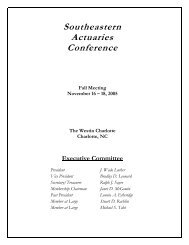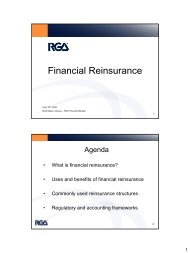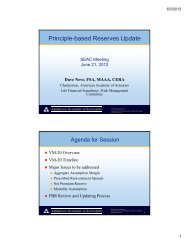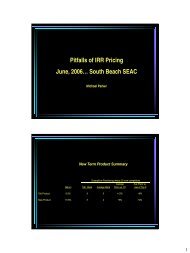The Financial Impact of Underwriting Class Exceptions
The Financial Impact of Underwriting Class Exceptions
The Financial Impact of Underwriting Class Exceptions
Create successful ePaper yourself
Turn your PDF publications into a flip-book with our unique Google optimized e-Paper software.
<strong>The</strong> <strong>Financial</strong> <strong>Impact</strong> <strong>of</strong><br />
<strong>Underwriting</strong> <strong>Class</strong> <strong>Exceptions</strong><br />
Jim Filmore, FSA, MAAA<br />
Second Vice President & Actuary<br />
Munich American Reassurance Company<br />
November 2006
Overview<br />
• Typical underwriting class structure<br />
• Example <strong>of</strong> 3 applicants<br />
• Graphical effect <strong>of</strong> class exceptions<br />
• Numerical effect <strong>of</strong> class exceptions
General Population Mortality Distribution<br />
Multiple Preferred UW <strong>Class</strong> Structure<br />
Pref + Pref Standard Substd Decline<br />
0 1<br />
Qx
Sample <strong>Underwriting</strong> Criteria<br />
Pref + Pref<br />
Standard<br />
Cholesterol < 210 < 240 < 300<br />
Ratio < 4.0 < 5.5 < 7.0<br />
Max. Weight 195 215 245<br />
(6 ft.)
<strong>Underwriting</strong> Information<br />
Individuals A, B, and C<br />
A B C Pref<br />
Cholesterol 238 245 175 < 240<br />
Ratio 5.3 2.5 2.8 < 5.5<br />
Max. Weight 212 175 220 < 215<br />
(6 ft.)<br />
Preferred? Yes No No
Preferred <strong>Underwriting</strong> Deviations<br />
Applicant A meets all <strong>of</strong> the preferred underwriting<br />
criteria. Applicant B does not meet all <strong>of</strong> the criteria, but<br />
overall is a better risk than applicant A.<br />
Should applicant B be eligible for a preferred rating also?
Preferred <strong>Class</strong> Without Deviations<br />
.<br />
B<br />
.<br />
A<br />
Pref +<br />
Preferred<br />
.<br />
C<br />
Standard<br />
0 Qx 1
Preferred <strong>Class</strong> with Deviations<br />
.<br />
B<br />
A<br />
.<br />
Preferred<br />
Standard<br />
Pref +<br />
.<br />
C<br />
0 Qx 1
Preferred <strong>Class</strong> with Deviations<br />
.<br />
B<br />
A<br />
.<br />
Preferred<br />
Standard<br />
Pref +<br />
.<br />
C<br />
0 Qx 1
Preferred <strong>Class</strong> with Deviations<br />
.<br />
B<br />
A<br />
.<br />
Preferred<br />
Standard<br />
Pref +<br />
.<br />
C<br />
0 Qx 1
Single Preferred <strong>Class</strong> UW Structure<br />
Numerical Example<br />
Pref Standard Substd Decline<br />
0 1<br />
Qx
Single Preferred <strong>Class</strong> UW Structure<br />
Numerical Example<br />
Pref Standard Substd Decline<br />
0 1<br />
Qx
Allocation <strong>of</strong> Term Premium Per Pricing<br />
Pr<strong>of</strong>it<br />
Expenses<br />
Mortality<br />
Capital/Reserves
Allocation <strong>of</strong> Term Premium after <strong>Exceptions</strong><br />
Pr<strong>of</strong>it<br />
Expenses<br />
Mortality<br />
Capital/Reserves
Increased Mortality from <strong>Class</strong> Shift<br />
Increased<br />
mortality<br />
Original mortality
Decreased Pr<strong>of</strong>itability from <strong>Class</strong> Shift<br />
Decrease in pr<strong>of</strong>it<br />
Remaining pr<strong>of</strong>it
Preferred <strong>Underwriting</strong> Deviations<br />
<strong>The</strong> shifting <strong>of</strong> risks from one underwriting class to a better<br />
class will have an impact on mortality.<br />
Keep in mind that a given percentage increase in mortality<br />
will have a much greater affect on pr<strong>of</strong>itability.
Multiple Preferred UW <strong>Class</strong> Structure<br />
Numerical Example<br />
Pref ++ Pref + Pref Standard Substd Decline<br />
0 1<br />
Qx
Closing Comments<br />
• Keep in mind that the impact <strong>of</strong> an underwriting class exception<br />
may be greater on the reinsurer (as compared to the direct<br />
company) as a much larger percentage <strong>of</strong> the reinsurers<br />
pr<strong>of</strong>itability is dependent upon an accurate mortality assessment.<br />
This can be especially poignant in the case <strong>of</strong> a permanent policy<br />
with a large single premium that may provide spread income for<br />
the direct company, but not to the reinsurer who is providing YRT<br />
reinsurance for the mortality risk.<br />
• What appears to be a small % increase in mortality actually has a<br />
much larger impact on the pr<strong>of</strong>it margin as the pr<strong>of</strong>its are a much<br />
smaller % <strong>of</strong> the total.
















